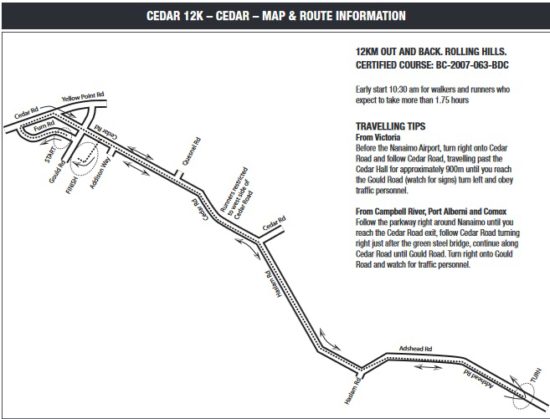The next race in the Vancouver Island Race Series is the Cedar 12k. This is a beautiful out-and-back course which features rolling hills and stunning countryside views.
Runners of all levels are welcome and there is an early start option for those who are walking. Whether it takes you less than 40 minutes to run 12k or it takes you over two hours, you can be assured that you will have a fun experience.
Personally, I’ve run this race quite a number of times and there is a reason why I keep coming back. I first ran it in 2013 and have done it every year except for last year. In 2016, I even broke 50 min in the 12k, which was (and still is) a big deal for me and a major milestone in my running.
I don’t think I will be doing that this year, but if all goes well I will be under 52 minutes. I’d be pleasantly surprised if I beat 52 minutes by anything more than a couple of seconds. However, as I’ve said before, I’m just thankful to be racing.
Also, from what I remember, the post-race food was very good!!
I’ve mentioned that it has a few rolling hills. However, as you can see from the map below, there are not that many turns. Without too many turns, you have a much better chance of running a good race even if you don’t run the tangents the entire way. However, you should still try to as much as possible.
So how do we run this race in order to have the best possible finish?
First, don’t start too fast. I followed my own advice for the Cobble Hill 10k and that really served me well.
It’s super tempting to bust right out of the gate because if you don’t know the course, it looks relatively easy on the map. The good news is that if you run it right-it is easy and fast. You can run a personal best.
In fact, when I did the Island Race Series in early 2016, I ran the 12k at a similar pace per km as the 10k. Therefore, you shouldn’t be too much slower per km at Cedar 12k than you were at Cobble Hill 10k if you save all your energy for the last 4k. Otherwise, those last 4k will feel like 40k (I’ve experienced that feeling too).
On the way to the turnaround point, I feel like there are more downhills. Therefore, save your energy for the way back as you will be coming back the same way. I always try to relax and coast on the way down (not always possible though).
Approaching the turnaround point will make you naturally have to slow down. However, after that, if you didn’t run the first few kms too fast, you should have a solid 2k or so.
Then, you will reach what I call “the big one”. I don’t fully remember if that hill is at km 8 or 9 but I remember there being one on the way back (the same one that you went down on the way to the turnaround point).
My biggest piece of advice here is to pay attention to any downhills on your way to the turnaround point because you will be going up them on the way back!

Above: As we can see, this is a grassy finish. Therefore, watch your footing a bit and be careful when you sprint towards the finish. Wearing: Public Myth.
After the 10.5k mark, the hills are not a problem. However, the last few hundred meters towards the finish is on the grass. Therefore, I try to be careful there and not sprint too hard towards the finish.
I hope you found this helpful!
Best of luck next Sunday and I hope to see you there! 🙂